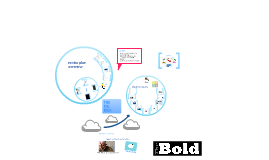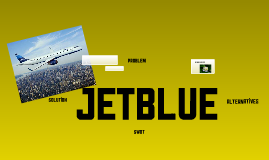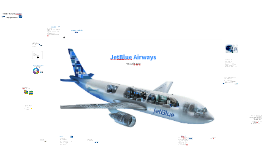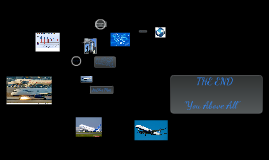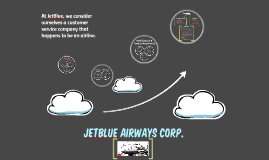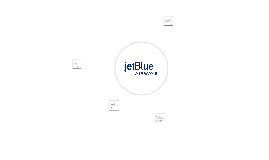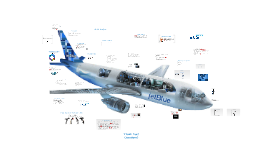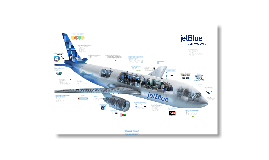Jetblue
Transcript: Rivalry Among Existing Competitors (Global Value Chains, 2006) (Promoting, 2009) History Entry Barriers Potential Competitors Economic advantage of new competition (JetBlue, n.d.) Introduction Founded in 1999 in New York 2001 posted a profit Increase safety on aircraft installing bulletproof dead bolted cockpit doors 2002 IPO = Success -> 5.87 shares totaling $158 million Currently carrying 30 million customers 82 cities 800 daily flights Environment One Thing That’s Green (2007) 80,000 trees in 2012 Lower Airfare Prices Complimentary Spa Packages Non-meal compliments Internal Environment Kenny Gott Danitza Meneses Kiyona Wilson 1. Fluctuating fuel prices 2. Rigid government regulations 3. Intense competition Air Transport World (ATW). (2014). ATW's 40th Annual Airline Industry Achievement Awards. From http:// atwonline.com/atws-40th-annualairline-industry-achievement awards. Boone, J. (2008). A New Way to Measure Competition. Economic Journal, 118(531), 1245- 1261. doi:10.1111/j.1468-0297.2008.02168.x Department of Transportation. (2013). Code Sharing. From http://www.dot.gov/policy/aviation-policy/licensing/ code-sharing. Global Value Chains - Concepts & Tools. (2006). Global Value Chains. From http://globalvaluechains.org/ concepts.html JetBlue. (n.d.). JetBlue. From http://www.jetblue.com/corporate-social-responsibility JetBlue Airways. (2014). Air Transport World, 51(2), 36. JetBlue Airways Corporation SWOT Analysis. (2014). JetBlue Airways Corporation SWOT Analysis, 1-9. JetBlue Press Releases. (2013). JetBlue Announces 2013 Annual Profit. From http://investor.jetblue.com/ phoenix.zhtml?c=131045&p=irol-newsArticle&ID=1894614&highlight=US Li, X. (2012). Group Buying, Buyer Heterogeneity, and Sellers' Bargaining Power* Group Buying, Buyer Heterogeneity, and Sellers' Bargaining Power. Decision Sciences, 43(5), 761-783. doi:10.1111/j.1540-5915.2012.00369.x Promoting competition to strengthen economic growth. (2009). OECD Economic Surveys: Belgium, 2009(12), 113-141. Top 30-Day Company in the Transportation Industry. (2014). Businessweek.com. From http:// investing.businessweek.com/research/sectorandindustry/industries/industrydetail.asp?code=203020&country=US Wansink, B. (1994). Advertising's Impact on Category Substitution. Journal Of Marketing Research (JMR), 31(4), 505-515. Wheelen, T. L., & Hunger, J. D. (2012). Strategic management and business policy: toward global sustainability (13th ed.). Upper Saddle River, N.J.: Pearson Prentice Hall. Threat of Substitute Products and Services Strengths (Boone, 2008) Weaknesses External Environment Profitability Gross profit margin (24.62%) Net profit margin (4.26 %) ROA (4.49%) ROE (10.52%) Liquidity Current ratio (0.8) Quick ratio (0.6) Leverage Debt to equity (38.4) Total debt to total assets (62.1) Activity Asset turnover (0.9) Accounts receivable turnover (48.7) Inventory turnover (28.5) Recommendations At JetBlue, we consider ourselves a customer service company that happens to be an airline. (JetBlue Press, 2013) (JetBlue Press, 2013) (Wheelen & Hunger, 2012) Threats of New Entrants 1. Strong brand recognition 2. Competitive service offerings 3. Low cost structure Bargaining Power of Buyers (JetBlue Airways Corp., 2014), (Wheelen and Hunger, 2012), (JetBlue, 2014) , (ATW, 2014) , (DOT, 2013) (JetBlue Airways Corp., 2014), (Wheelen and Hunger, 2012), (JetBlue, 2014) , (ATW, 2014) , (DOT, 2013) (Li, X, 2012) References JetBlue Airways Corporation-top discount airline with an inspiring success story Anti-establishment airline David Neeleman/David Barger (CEOs) Visions-safety, caring, integrity, fun and passion SWOT Analysis & Financial Performance Value Chain 1. Board and Committee Composition 2. Policy on Annual Meeting Attendance 3. Policy on Stockholder Communications with the Board 4. Policy on Consideration of Director Candidates Recommended by Stockholders 5. Qualifications and Process for Selection of Director Candidates 6. Director Resignation Policy 7. Code of Business Conduct and JetBlue’s Values JETBLUE Airfares and other Airlines 2004-2005 Chapter 11 Bankruptcy New entrant to industry leader Focus: Core values and the customer Low cost leader, despite not sacrificing quality High-tech and highly comfortable Not performing at the same level as some competitors (e.g. Southwest); however, they have been successfully on an individual level 2013 Net income: $168 million With its sights set on expansion, JetBlue will continue facing challenges Fluctuating fuel prices, high fixed costs, rigid government regulations, and significant amounts of debt financing JetBlue’s optimism, creativity, and innovation might just make it a reality Overall, JetBlue has been successful at meeting their goal Bringing humanity back to the skies The Return to Profitability Plan vs. (JetBlue Press, 2013), (Top 30-Day, 2014) Opportunities Goals & Objectives 1. Growing industry 2. Commercial partnership Youth and education Soar with Reading (2011) Community Community






